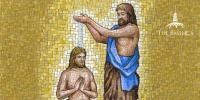
During the Christmas period we have read how the infant Jesus was made known firstly to the Jewish shepherds and secondly to the gentile Magi. The scene is now set for the appearance of Jesus at the River Jordan. The New Testament constantly recalls events in the past history of Israel, bringing to mind God’s plan as it evolved. The river Jordan is rich in symbolism: Naaman the Syrian was cleansed of his leprosy there, and the Jews crossed the river to enter the Promised Land. New beginnings and freedom from oppression are thus heralded.
The people would be familiar with the rite of baptism as a means of cleansing sin. They would therefore have understood the meaning of John’s baptism. Jesus of course had no need of this as he was sinless; however he wanted to identify himself completely with his people, as the servant whom Isaiah describes in today's first reading. From the beginning of his ministry he was manifesting himself as very different from the Messiah who was expected.
God incarnate, the second person of the Trinity, was proclaimed by the Father as his beloved son; and the Holy Spirit, in the form of a dove, descended on him. He had come from a very ordinary life as the village carpenter and now he received affirmation from above. It was the sign for him to begin his work and for John the Baptist to fade into the background. He introduced Jesus as the Lamb of God, and two of his disciples left to follow him (John 1:35-37). John's work was done.